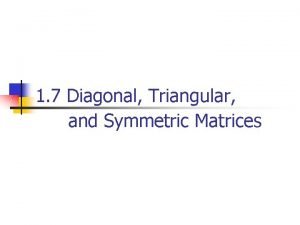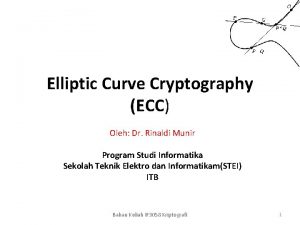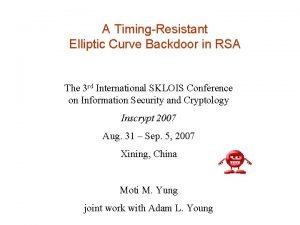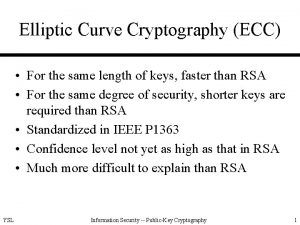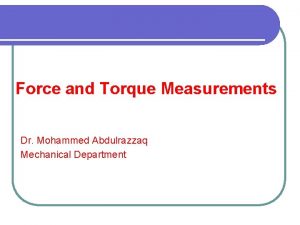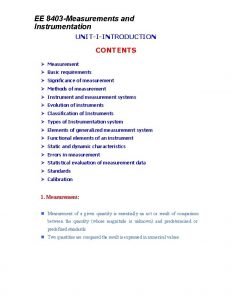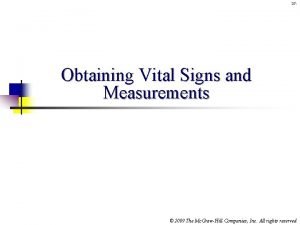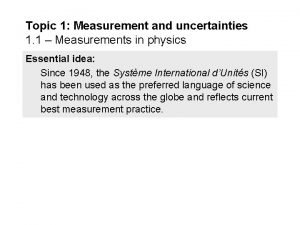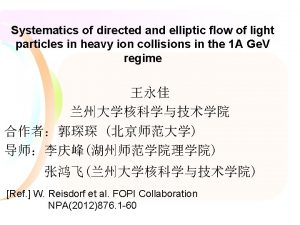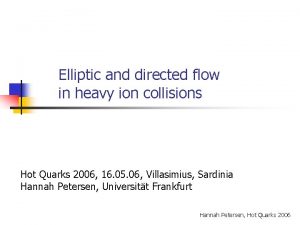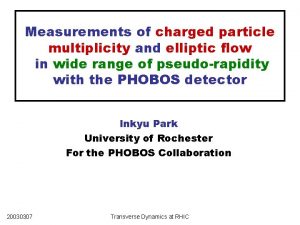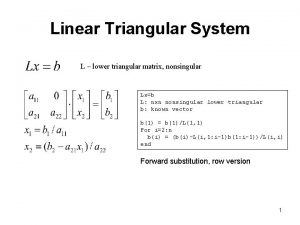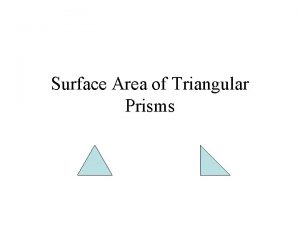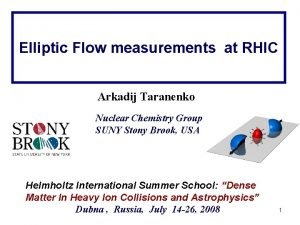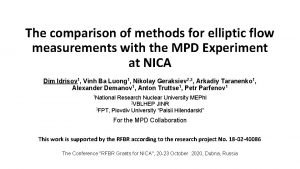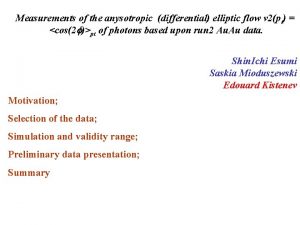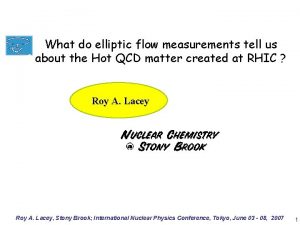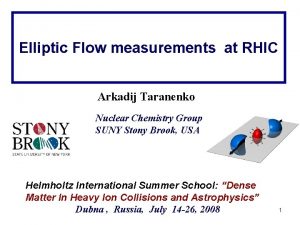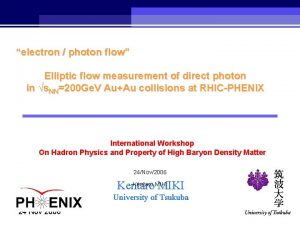Measurements of directed elliptic and triangular flow in





























- Slides: 29

Measurements of directed, elliptic, and triangular flow in Cu+Au collisions at √SNN= 200 Ge. V using the PHENIX detector at RHIC High Energy Physics in the LHC Era 2016 6 th International Workshop Vicki Greene for the PHENIX Collaboration Vanderbilt University 7 January 2016 1

Outline • Introduction • Detector configuration • Directed, elliptic, and triangular flow • Charged particles • Identified hadrons • Scaling behavior • Other collision systems • Model comparisons • Conclusions 2

An example of anisotropic flow: Elliptic Flow Elliptic flow: initial spatial anisotropy pressure gradients momentum anisotropy 3

Anisotropic Flow Harmonics – Event Plane Method 4

Anisotropic flow harmonics • Reflect properties of initial state and evolution of collision system • Probe different length scales • Sensitive to Equation of State and viscosity/entropy ratio h/s • Uncertainties in energy density deposition in initial state are limiting factor in deducing h/s • Asymmetric collisions probe effect of initial geometry 5

v 1 sign conventions used v 1 is defined to be positive at positive h (Cu-going) • x is positive if spectators flow outwards • Measurements use Au spectators, signs are flipped • 6

7

Collision Systems at BNL-RHIC • Au+Au • p+p • d+Au • Cu+Cu • U+U • Cu+Au • He+Au • p+Al PHENIX data in this analysis • Run 12 (2012) • 200 Ge. V • 5 weeks • 7. 6 B events • |h| < 0. 35 • ar. Xiv: 1509. 07784 8

Event Plane Resolution three sub-event method used to determine the resolution: Y 1 : SMDS, Y 2, 3 : BBCS+BBSN 9

Centrality Dependence v 1 Magnitude decreases from central to more peripheral events V 2 Magnitude increases from central to more peripheral events 10

Centrality Dependence v 3 Weak centrality dependence – dominated by fluctuations v 2 Magnitude increases from central to more peripheral events 11

v 2 System size dependence: Au+Au, Cu+Cu Cu+Au v 2 lies between Cu+Cu and Au+Au 12

v 2 (e 2 scaled) e 2 scaling reorders the results by system size 13

v 2 (e 2 Npart 1/3 scaled ) – length scale universal behavior in all centralities and systems: Cu+Cu, Cu+Au, Au+Au 14

For the same centrality, e 3 is larger in the smaller system due to increased fluctuations 15

v 3 system size dependence v 3 Cu+Au > v 3 Au+Au 16

v 3 (e 3 scaled) Close agreement at low-intermediate p. T Within systematic uncertainties at high p. T 17

V 3 scaled by e 3 Npart 1/3 Agreement within systematic uncertainties at all p. T 18

Identified particle v 2 Mass ordering at low p. T for v 2 for all centralities 19

Identified particle v 1 and v 3 v 1 v 3 Mass ordering at low p. T for v 1, 3 20

v 1 comparison to viscous hydrodynamics P. Bozek, Phys. Lett. B 717 (2012) 287 |h| < 0. 35 |h| < 1. 0 Indirect comparison shows qualitative agreement, assuming spectators curl outward from the z-vertex 21

v 2 and v 3 comparison to viscous hydrodynamics v 2 For 0 -5% centrality, η/s =0. 8 better reproduces data For 20 -30% centrality, both values of η/s agree with data v 3 22

Comparison to AMPT v 2 v 3 23

Conclusions • In Cu+Au the magnitude of v 1 decreases from central to peripheral, opposite to v 2 behavior. v 3 is not strongly centrality-dependent • System size comparison: v 2, 3 in different systems scale with e 2, 3 Npart 1/3. • Mass ordering is seen for all harmonics. • v 2 and v 3 are consistent with viscous hydrodynamics • AMPT with s = 3. 0 mb describes v 2 and v 3 for p. T < 2 Ge. V. 24

backup 25

backup 26

backup 27

Contributions to systematic uncertainties • • • Event plane resolution correction Event plane using different detectors Vn from background tracks Acceptance dependencies PID purity 28

PHENIX Run 12 Detector Configuration 29
 Syntax directed definition and syntax directed translation
Syntax directed definition and syntax directed translation Elliptic curves number theory and cryptography
Elliptic curves number theory and cryptography Symmetric matrix
Symmetric matrix Elliptic genitive
Elliptic genitive Elliptic curve discrete logarithm problem
Elliptic curve discrete logarithm problem Motivationsbasis
Motivationsbasis Elliptic curve cryptography applications
Elliptic curve cryptography applications Elliptic curve cryptography
Elliptic curve cryptography Elliptic curve
Elliptic curve Elliptic curve backdoor
Elliptic curve backdoor Elliptic curve cryptography
Elliptic curve cryptography Lieberman
Lieberman Elliptic curve diffie hellman example
Elliptic curve diffie hellman example Elliptic curve cryptography
Elliptic curve cryptography Dfd to structure chart
Dfd to structure chart Transform flow and transaction flow
Transform flow and transaction flow Irrotational flow meaning
Irrotational flow meaning Internal flow and external flow
Internal flow and external flow Control flow and data flow computers
Control flow and data flow computers Annubar vs pitot tube
Annubar vs pitot tube Measurements equivalents and adjustments
Measurements equivalents and adjustments Chapter 2 measurements and calculations
Chapter 2 measurements and calculations Force and torque measurements
Force and torque measurements Ee8403 measurements and instrumentation
Ee8403 measurements and instrumentation Anthropometric measurement includes vital signs
Anthropometric measurement includes vital signs Chapter 37 vital signs and measurements
Chapter 37 vital signs and measurements Segment lengths intersecting chords secants and tangents
Segment lengths intersecting chords secants and tangents Normal vital signs
Normal vital signs Vital signs and anthropometric measurements:
Vital signs and anthropometric measurements: Measurements and uncertainties ib physics
Measurements and uncertainties ib physics


